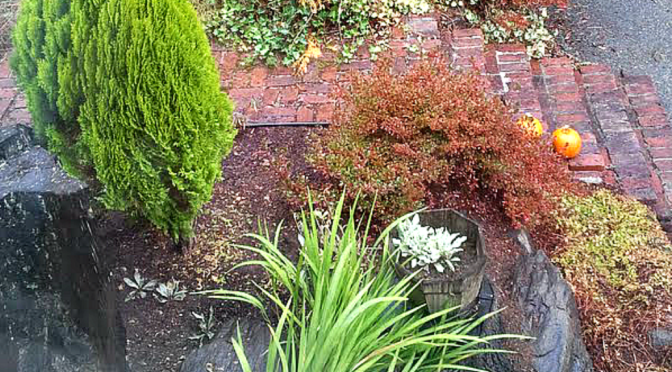One year’s seeding makes seven years’ weeding. ~ anonymous proverb
I can relate to this quote because this year the margin in my life shrank and finally went away altogether, so that weeds flourished in my garden, demonstrating my inability to function to the world at large. I’m not okay with that. In fact, it is one of the frustrations that prompted me to seek a simple life.
To tackle the weeds in my yard, I’ve developed a system that works well for me. I fill two buckets a day, spending from 15 minutes to an hour, depending on the size of the weeds. On days when I have less time to spare, I combat larger weeds, filling my buckets quickly. Other days, I weed in more detail while birds sing in the bushes all around me and sweet breezes caress my face.
You don’t cover a lot of space at a time by this method, but it’s amazing how much I’ve been able to accomplish, The key is consistency. Think of the perseverence of the ant and you’ll have a picture of the mindset this takes. If you’re having trouble getting to your garden, why not try it?
My Yard Maintenance System
Divide your yard into areas, which you prioritize. Starting with your most urgent area, complete the following steps:
Clear all weeds from each bed, one at a time so you can have a feeling of victory each time you finish a bed. Leave all the good plants in the soil for now, even if they aren’t where you want them. Moving them around or potting them after the beds are cleared saves time because you can drag out the shovel, pots, and soil mixture just once to do them all. Sometimes I listen to podcasts or make phone calls during my weeding sessions, letting me do two things at once.
Prune all bushes and bribe the kids to pluck the leaves off the prunings and put them in a compostable bag, or you can just lay them somewhere sunny to dry and scrape the brittle leaves off with gloved hands. Dry leaves make an excellent free mulch, something that will keep more weeds from sprouting to replace the ones you pulled.
Remove any bushes, tree roots, or stumps that need to be dug up. Before you spend a lot of labor taking out a stump, see if you can make it a garden feature instead. The picture of my garden in the image, below, shows a stump on the left side and also one serving as a stand for a small planter. I was going to dig out the larger of these stumps when my husband mentioned that he thought it was kind of cute. I didn’t believe him until looked with new eyes. One note: if you leave a stump near the house, keep an eye on it for possible carpenter ant invasions that could transfer to the house.
Pot any plants you want to move elsewhere. If a plant is too large for a pot, you’ll have to dig a spot for it in its new location and move it right away. Either that, or you can keep plants temporarily by covering their roots with soil inside a compostable bag. Be sure to spray in a little water and, until you return it to the soil, check to make sure the roots don’t dry out.
Now rearrange the remaining plants in this one area. This can be fun, like rearranging furniture. You may also want to add in new plants or transplants from other beds to fill gaps.
Add mulch. Take the leaves you saved from your pruning and either weedwack inside the bag or dump them on bare ground and run the lawn mower over them. Shovel them back into beds to act as a mulch. if you need more mulch, shredded bark is a good alternative. Wood has a weed-suppressing quality. To add extra oomph to any mulch you put down, place a thick layer of newspaper down first. I once went to a local newspaper office and asked for unsold papers they were going to trash. I filled my trunk for free and used it beneath bark mulch to successfully smother dandelions.
Weeding Wisely
It’s hard to focus on just one area when your whole yard is running rampant, but it does help when you begin to see results. Next year I will only have light weeding in the areas I’ve worked this year.
I won’t hang up my trowel at the end of the season but will continue weeding in short bursts until snow covers the ground. Winter weeds can creep up on a bed when you least suspect it, and in our area, depending of the weather, dandelions can start setting flowers as early as January. Attacking when weeds are dormant gives you an advantage. By all means pull weeds in the winter, however, don’t try to work the soil until it’s ready or you’ll ruin its crumb texture.
Time-Saving Weeding Techniques
- Use a screwdriver to prise out roots with less effort.
- An old knife slips easily into cracks between pavers.
- Vinegar kills weeds. Sometimes you need a couple of applications.
- Bleach kills moss, so that all you have to do is sweep it up. Reapply to remove thick patches.
- When weeds are flowering or seeding and you know you won’t get to them all, fill a bucket a day with seedheads. Children especially love plucking flowers and seed pods.
- For a truly weed-infested patch, rather than trying to clear out the mess, sometimes it’s best to cover it with carpet, straw, tarp, or plastic mulch to smother weeds. Once the weeds are dead, you can remove any non-organic coverings, enrich to soil with amendments if needed, and lay down a heavy layer of mulch. Wait a season and pluck out any weed starts that come to the surface before planting. Note: plastic mulch is my last choice here because it can damage the soil and kill beneficial worms and other soil-bound critters. If you resort to it, leave it on no longer than three months.
- Before purchasing plants in containers, check them for insects, deseases, and weeds.
- When buying compost, manure, and topsoil, ask if it’s been processed to a temperature of between 140 F and 150 F to ensure weed seeds are killed.
- In designing my own gardens, I plant an ornamental plant anywhere a weed will want to grow. I’d rather tend pretty flowers than pull weeds any day.
- Native plants will usually flourish if you locate them in spots with the proper light and moisture requirements. Healthy plants crowd out weeds much better than languishing ones.
Some Final Thoughts
I hope my weeding techniques help and encourage you. Don’t give up, even when your yard looks hopeless. Before long you’ll free your time in the garden for things you enjoy more, like wandering the paths and smelling the flowers.
©2014 by Janalyn Voigt




Hi my friend,
Nicely written. Keep weeding, keep gardening, keep writing! Hope you’re well.
I think of you often.
T
Hi, Tina. Thanks for stopping by. I’m doing fine, but my schedule reached overload capacity, so I’ve been paring back and simplifying everything I do. I think of you often, too, living in your little slice of heaven. :o)